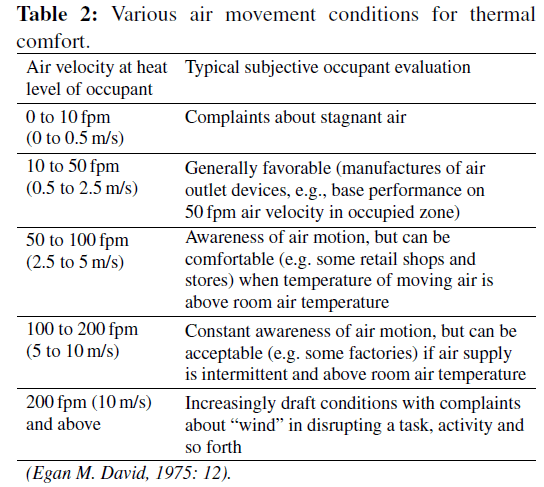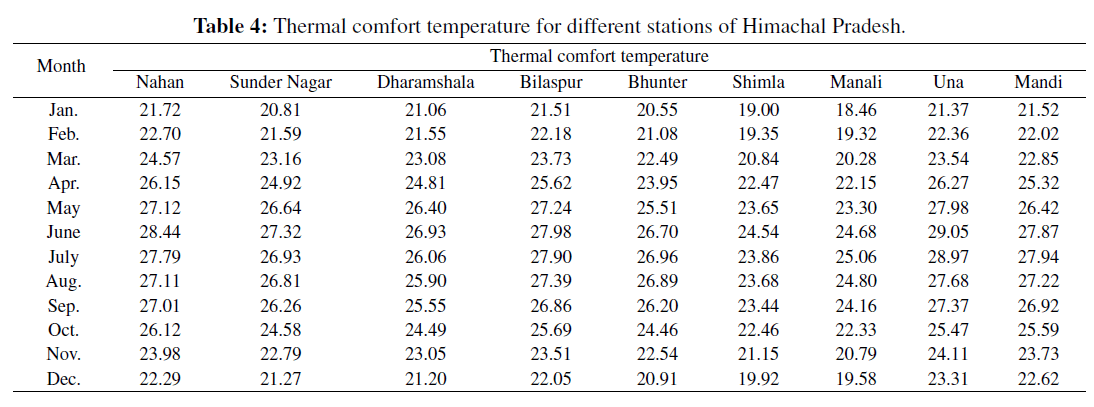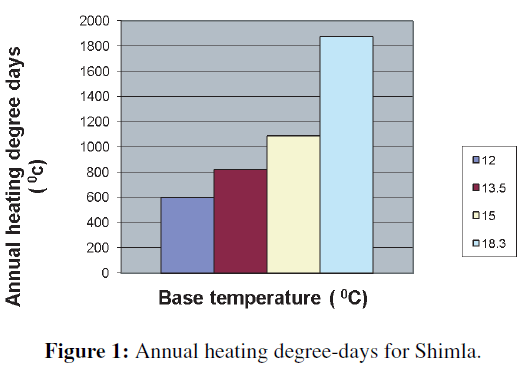Thermal Comfort Temperature Standards for Cold Regions
Received: 28-Jan-2012 / Accepted Date: 24-May-2012 / Published Date: 29-May-2012
Abstract
A new approach to redefine thermal comfort temperature for cold climatic hilly regions is presented. This approach will lead to the reduction of base temperature, number of winter space heating degree-days required and helps in the designing and proper sizing of space heating systems, and thus reducing the initial high costs of solar passive features. The new thermal comfort temperature has been proposed and used in the passive solar design of a Bank building at Shimla (Latitude 31.1 °N, Longitude 77.1 °E and Altitude 2202m (above msl)) the capital of Himachal Pradesh, the Western Himalayan State in India. The monitoring of building shows that a new thermal comfort temperature results in reducing the heating requirement by about 44%, thereby indicating the need to adopt this approach for cold regions.
Keywords: Thermal comfort temperature; Heating demand; Cold regions; Passive solar building
19789Introduction
The estimation of heating requirements of a building is essential for its effective passive solar design. A passive solar building program is being coordinated by one of the authors in the Western Himalayan state of Himachal Pradesh [2].
India has diverse climates, thus it is not proper to define a single comfortable temperature for the entire country, as it will vary region wise. For Indian conditions, the base temperature needs to be redefined, as the comfortable temperature inside a building needs not to be taken as 23.8°C (with 18.3°C as base temperature+5.5°C) [7] defined for American climatic conditions.
ASHRAE recommends that relative humidity be maintained below 60%. There is no recommended lower level of humidity for achieving thermal comfort, but very low humidity can lead to increased static electricity and health problems, such as skin irritation. The relative humidity should be greater than 30%. Table 1 shows ASHRAE’s acceptable ranges of operative temperature (a combination of air and radiant temperatures) for relative humidity levels of 30% and 60%. If the relative humidity is very high, the heat loss by evaporation will be much greater, so raising the temperature is one practical way to compensate for the extra loss by evaporation. When temperatures are within the comfort range (19–23°C) the RH has a little effect on comfort provided that it is within the range of 40–70%. Influence of humidity is not great for a person with very light or sedentary activities as well. Higher humidity will make a person feel warmer particularly in a ventilated area where the air speed is low. In areas of very low humidity, people may experience discomfort from dry eyes, nose and throat.
The optimum air temperature in UK is 18.3°C, but the range of requirement for comfort could vary from 15.6°C to 20°C for light factory-work depending upon the degree of comfort required. But, in sedentary occupations, the range might be 19.4°C to 22.8°C, while for heavy work 12.8°C to 15.6°C could be considered acceptable [1]. Table 2 describes how human occupants react to various conditions of room air motion.
The thermal comfort is a state of mind where a person expresses satisfaction with the thermal environment (ASHRAE Standard 55 2004). People in India also use warm clothing (sweater, jacket, inner thermal, socks, cap) in winters as compared to 0.9 clothing [sweater, long sleeve shirt, heavy slacks] (ASHRAE 1955–1981), thus a higher inside temperature need not to be created by the heating systems as recommended 22.7°C (ASHRAE 1955–1981). A lower base temperature is needed which will result in saving of considerable fuels. Also people in hills have adapted themselves to be comfortable at lower temperatures in winters and in plains at higher temperatures in summers and this aspect needs to be kept into consideration while determining new comfort temperatures. The adopted principle of Nicol et al. [7] has been supported by field comfort studies in different climates. Humphreys [3] found that the comfort temperature differed between groups of people feeling thermally comfortable. According to Nicol and Humphreys, the mean comfort rating changed less with indoor temperature from climate to climate than might be expected.
Thermal comfort temperature (Tc) for a particular location helps in estimating the heating requirements and in the calculation of heating degree-days. The thermal comfort temperature (Tc) for winters is generally taken as 23.8°C with light clothing and 29.4°C for summers. The air conditioning engineers design solar energy systems by taking the standard thermal comfort temperature as 22°C. However, this design temperature requires to be redefined for hilly regions. As per ISO 7733 calculations, the preferred operative temperature is 22°C, in case of three-seat sofa the operative temperature would have to be 1.5°C lower.
As there is very little thermal comfort research in India other than by a few [4], thermal comfort standards are not defined in Indian Codes. For all climate and building types, the National Building Code of India specifies the use of two narrow ranges of temperature: summer (23–26°C) and winter (21–23°C), (BEE, 2005). These standards are based on ASHRAE standards, which are not validated through empirical studies on local subjects. The application of these standards is known to produce overdesigned thermal monotony, leading to exorbitant energy misuse.
Energy consumption in buildings is also increasing at an unprecedented rate, as more and more buildings are designed in lightweight materials like glass and aluminum, giving little importance to the passive methods of heat control and human adaptation to comfort. It is well known now that buildings with poor adaptive opportunities often produce intolerable indoor conditions within, and consume high energy.
Keeping these aspects in view, the heating degree-days with new base temperature for different locations of this Western Himalayan State have been estimated. The heating demand of a building without solar passive features and with solar passive features has been estimated with new thermal comfort temperature in the following sections.
Methodology
Based upon a comfort survey conducted all over the world, a relation has been derived between comfort temperature (Tc) and outdoor temperature (T0) [3] as
 (1)
(1)
Another relation was obtained for Pakistan [8], which has almost similar climatic conditions as in India as
 (2)
(2)
The SCATS survey based in 5 European Countries has increased the accuracy and applicability of the model by showing that it was the running mean of the daily mean outdoor temperatures which correlated best with indoor comfort (McCartney and Nicol 2002) with the assumptions that thermal resistance of the clothing is 0.5 clo, metabolic rate is 1.4, met air velocity is 0.15 m/s, and relative humidity is 50% [9],
 (3)
(3)
The month-wise thermal comfort temperatures TCH calculated by [3], TCN1 calculated by [8] and TCN2 calculated by [9] and outside temperature for Shimla are presented in Table 3.
Table 3 reveals that the thermal comfort temperature obtained by [3] is quite low in the range of 14.1°C–18.7°C and [8] predicts the thermal comfort temperature in the range of 18.5°C–21.7°C whereas [9] predicts the thermal comfort temperature in the range of 20.5°C–25.3°C. Thus, relation (2) has been used to estimate the thermal comfort temperature for different stations in the state.
In the present study, thermal comfortable temperature of 19°C is taken for the coldest month of winters for Shimla using relation (2) on the basis of survey carried out in the local area on pilot basis. Also the winter comfort temperature comes out to be 19.1°C when outside temperature is 17°C [8]. The thermal comfort temperatures for different stations of Himachal Pradesh using relation (2) are presented in Table 4.
Estimation Of Degree-days
Once the comfort temperature is known, the degree-days which are essential to estimate the heating demand of the building can be calculated using the relation
 (4)
(4)
where Tb is the base temperature and To is the average outside temperature.
A large quantity of energy is required to heat the buildings in winters. The fuel consumption depends upon heating demand of a building, which is related to heating degreedays for a particular location. The heating degree-days are based upon the base temperature and average outside temperature. The annual heating degree-days at different base temperatures for Shimla are presented in Figure 1.
The heating degree-days with new base temperature can be calculated using the following relation:
 (5)
(5)
where Dm is monthly degree-days, ΔTb is the difference between degree-days base and monthly average temperature in °C, Nm is the number of days in a month and Da the annual degree days at base temperature of 18.3°C at the location [6]. This relation is valid for locations having heating degree-days (1000–4000). Based on results [8], the new comfortable temperature is 19°C, with base temperature as 13.5 °C for calculating heating degree-days. Figure 1 also reveal that the annual heating degree-days of all the stations are reduced using base temperature of 13.5°C than those with base temperature of 18.3°C. However, heating degree-days can be calculated using relation (3) with sufficient accuracy.
Estimation Of Annual Heating Requirements Of A Passive Solar Building
A passive solar HP Co-operative Bank building at Shimla (Latitude 31.1 °N, Longitude 77.1 °E and Altitude 2202m (above msl)) is taken as a case study to evaluate the thermal performance. This building is a multistorey RCC structure. The narrow front of the building is exposed to Southern sun in winter. The longer East face of the building has no access to light and air as it is adjoining to another building. The West face has access to sun and air from adjacent lane. The North side of the building opens towards valley side.
The solar passive features of the building include the following: orientation of building is 10° west of south; air lock lobby at the main entrance to reduce heat losses; external walls (north, south, and west) are 9'' thick (double brick wall); eastern wall is 18'' thick brick wall adjoining another [State Bank of Patiala] building; two sun-spaces each of size 1.8m2 have been provided on the south face on 1st and 2nd floors; a heat collecting solar wall with 36m2 glass area, on the front south face has been constructed, tightly sealed double glazed windows with separate wooden frame shutters on west and north sides of 4mm thick glass to reduce heat losses; Buffer zones have been created on the north face of building to reduce heat losses; West walls of the officer rooms have been insulated by wooden paneling. This wall remains shaded by adjoining building, all exposed roofs/ceiling are thermally insulated by an equivalent of 50mm thick resin bonded mineral wool, tight sealing of windows to avoid infiltration of air.
The evaluation of the building has been carried out with assumptions such as there is no heat loss through the internal walls, floors and ceilings (these are insulated by an equivalent of 50mm thick resin bonded mineral wool), East wall as it is common with 8 another adjoining building wall (thickness increases) and North wall (due to buffer zone), building is for day time use only (10:00 am to 5:00 pm), solar heat gain through west wall has not been taken into account as no sun is available to the building due to shading by adjoining building (walls are very close to each other), heating is required only for five winter months (November to March).
The climatic data of Shimla has been presented in Table 5 and building parameters have been given in Table 6.
The degree-days can be used to estimate the annual heating requirement of the building with expected variation of ± 20% [5]. Large buildings with many zones cannot be evaluated using degree-days method and other methods are to be used to account for internal gain and building mass effects.
The heating demand of the building is calculated as
 (6)
(6)
here N is number of air changes per hour and V is volume of the building. UA is the heat loss coefficient of the building and D is heating degree-days. The heating requirement of original design building [D1] without any solar passive features with volume of 3065m3 and improved design building [D2] with solar passive features with volume of 2283m3 have been calculated. The number of air changes per hour (N) in building [D1] is taken as 4 whereas in building [D2] the value of N is taken as 3. The low value of N is taken in D2 because the building is considered to be tight due to air lock lobby, insulated roof and 9 buffer zone. The heating demand of the building [D1] is 58% less at base temperature of 13.5 °C than at base temperature of 18.3°C.
The annual heating demand of [D2] calculated using relation (5) at base temperatures 18.3°C and 13.5°C reveals that the heating demand in building [D2] has been reduced by 44.54% in comparison to building [D1] at similar base temperature of 13.50. The infiltration heat loss, which is a major part of total heat loss of the building, has been reduced by 44% in building [D2] in comparison to building [D1] mainly due to the exclusion of volume of buffer zone created at North side. The insulated roof has reduced the heating demand by 56% in comparison to existing roof.
Conclusions
The new base temperature of 13.5°C results in reducing the heating degree-days by 58% in comparison to the heating degree-days obtained using 18.3°C as base temperature. The lower base temperature has also reduced the heating requirements of solar passive building by 44%, thus resulted in lowering of cost on solar energy heating systems and the conventional fuel bill.
ASHRAE standard 55 (1981). Thermal environmental conditions for human occupancy.
ASHRAE standard 55 (2005). Thermal environmental conditions for human occupancy.
References
- J. N. Chalkley and H. R. Carter, Thermal Environment, Architec- tural Press, London, 1968.
- S. S. Chandel, S. King, and D. Prasad, Implementing passive solar housing technology in mountains, in Bringing Solar Down to Earth: Proceedings of ISES, W. Y. Saman and W. W. S. Charters, eds., Solar World Congress, Adelaide, Australia, 2001, 183–189.
- M. A. Humphreys, Outdoor temperatures and comfort indoors, Batiment International, Building Research and Practice, 6 (1978), 92.
- M. Indraganti, Adaptive use of natural ventilation for thermal comfort in Indian apartments, Building and Environment, 45 (2010), 1490–1507.
- J. F. Kreider, The Solar Heating Design Process: Active and Passive Systems, McGraw-Hill, New York, 1982.
- J. Lunde Peter, Solar Thermal Engineering Space Heating and Hot Water Systems, John Wiley & Sons, New York, 1980.
- J. F. Nicol and M. A. Humphreys, Adaptive thermal comfort and sustainable thermal standards for buildings, Energy and Buildings, 34 (2002), 563–572.
- J. F. Nicol, G. N. Jamy, O. Sykes, M. A. Humphreys, S. Roaf, and M. Hancock, Survey of Thermal Comfort in Pakistan: Towards New Indoor Air Temperature Standards, Oxford Brookes University, School of Architecture, Oxford, 1994.
- J. F. Nicol and L. Pagliano, Allowing for thermal comfort in free- running buildings in the new European Standard EN15251, in 2nd PALENC Conference and 28th AIVC Conference on Building Low Energy Cooling and Advanced Ventilation Technologies in the 21st Century, Crete island, Greece, 2007.
Citation: Chandel SS (2012) Thermal Comfort Temperature Standards for Cold Regions. InnovativeEnergy Policies 2: 106.
Copyright: ©2012 Chandel SS, et al. This is an open-access article distributed under the terms of the Creative Commons Attribution License, which permits unrestricted use, distribution, and reproduction in any medium, provided the original author and source are credited.
Share This Article
Recommended Journals
Open Access Journals
Article Usage
- Total views: 16553
- [From(publication date): 12-2012 - Dec 18, 2024]
- Breakdown by view type
- HTML page views: 12085
- PDF downloads: 4468







